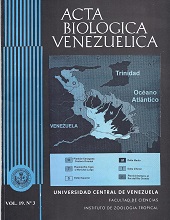IS THE OPISTOGLYPH Clelia clelia DUVERNOY'S GLAND SECRETION HAEMORRHAGIC IN HUMANS?
Palabras clave:
Duvernoy´s gland secretion, chicken embryos, Clelia clelia, snake venom, Bothrops lanceolatusResumen
A rodent alternative to the measurement of Duvernoy´s gland secretion (DGS) haemorrhagic effects using hens´eggs is proposed. We have used a non-sentient living system, such as very young stage of the chick embryo, as an option to haemorrhagic testing in mammals. The yolk sac membrane offers an easy observation vascular system. None haemorrhagic lesion in hens´eggs was observed with Clelia clelia DGS. Bothrops lanceolatus positive control showed a halo distant the square and bleeding was also present around the sector below the square. Although in patients ' clinical cases bitten by Clelia clelia haemorrhagic activities are evidenced, haemorrhagic was not experimentally demonstrated, making to suspect that the echymosis and petechias presence are processes of allergic nature produced by substances such as proteins, enzyrnes, carbohydrates and short peptides components of DGS from Clelia clelia snake.


